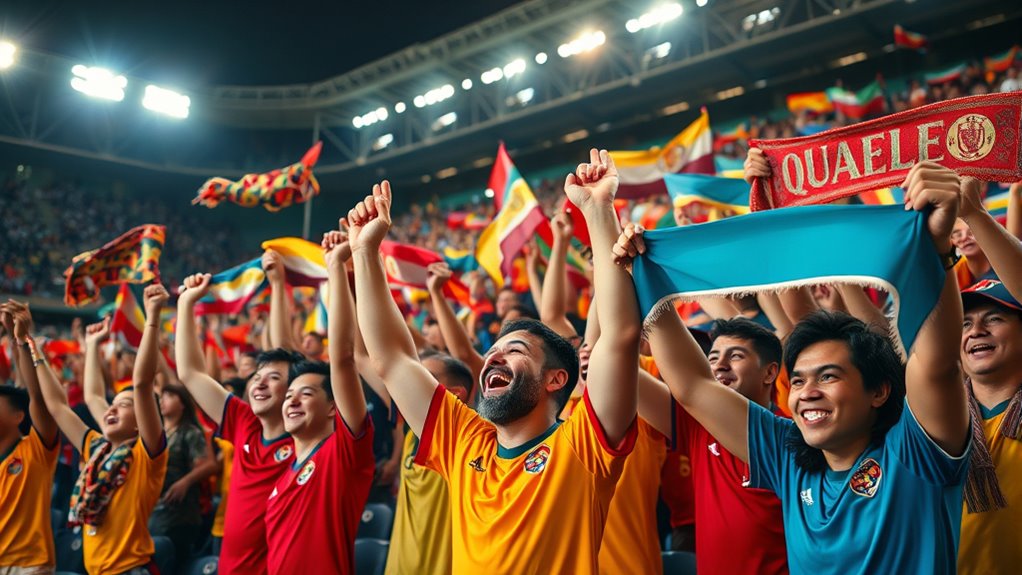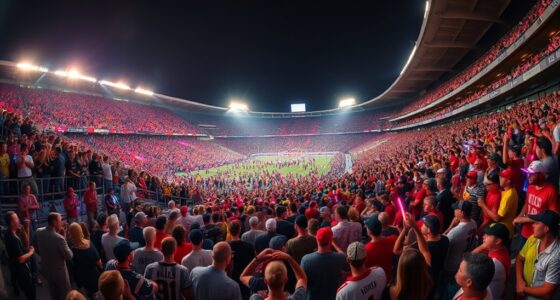Fan chants have a rich history rooted in communal traditions, evolving from spontaneous expressions to organized rituals that boost team spirit and foster social bonds. They reflect regional cultures, symbols, and shared identities, connecting supporters across generations. These vocal rituals serve social functions like reinforcing loyalty, creating belonging, and shaping group identity. Modern technology amplifies their reach worldwide, allowing fans to innovate and share chants easily. Exploring further reveals how these chants reveal deep cultural meanings and community values.
Key Takeaways
- Fan chants have a long history rooted in communal traditions, serving as expressions of enthusiasm and cultural identity.
- They foster social cohesion, group loyalty, and emotional bonds among supporters during sporting events.
- Cultural variations influence chant styles, incorporating local symbols, language, and motifs to reflect regional identities.
- Modern technology enables the spread and innovation of chants through social media, creating global digital fan communities.
- Fan chants function as rituals that reinforce community values, tradition, and collective pride across generations.
The Historical Roots of Fan Chants
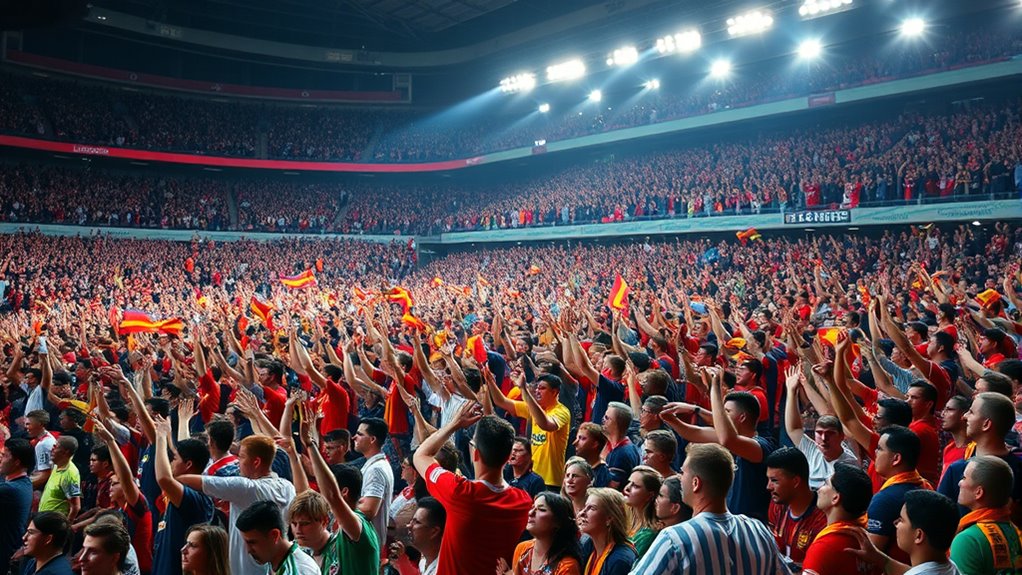
Fan chants have a long history that traces back to early sporting events and communal gatherings where fans found ways to show their support and unity. The historical origins of chant development reveal how fans used simple, rhythmic chants to boost morale and create a sense of belonging. These chants often started as spontaneous expressions of enthusiasm, gradually evolving into structured vocal rituals. Over time, different cultures and sports adopted unique chant styles that reflected their traditions and identities. You can see how these chants served not just as encouragement but also as a way to connect fans across generations. The development of these vocal rituals highlights their importance in fostering community spirit and enhancing the overall sporting experience. Additionally, understanding what makes a chant effective helps explain why certain phrases and melodies resonate so deeply with fans.
Functions and Social Significance of Vocal Rituals

Vocal rituals like chants serve more than just motivating players; they play an essential role in strengthening the social fabric of sports communities. Through affective bonding, fans feel a deeper connection to their team and fellow supporters, creating a sense of unity and shared identity. These chants act as ritual reinforcement, establishing traditions that deepen collective pride and loyalty over time. When you join in chanting, you’re not only boosting team morale but also reaffirming your belonging within a community. The act of vocalizing together fosters trust and camaraderie, making fans feel part of something larger than themselves. Interestingly, forsale 100 indicates the widespread popularity of organized fan chants and their influence on team branding. Ultimately, these rituals help sustain social cohesion, ensuring that the communal spirit endures through generations of passionate supporters.
Cultural Variations in Fan Chanting Practices

Cultural backgrounds considerably influence how supporters express their loyalty through chanting. As a sports fanatic, you’ll notice that chant diversity varies widely across regions. Different countries bring unique melodies, languages, and themes into their cheers. For example:
Cultural backgrounds deeply shape the unique chants and traditions fans bring to the stadiums worldwide.
- In Latin America, chants often feature rhythmic clapping and call-and-response patterns.
- In Europe, supporters may combine chants with intricate choreography and flags.
- In Asia, chants often incorporate traditional instruments and local phrases.
This diversity reflects deep-rooted cultural identities, shaping how fans connect with their teams. Sports fanatics from different backgrounds bring their traditions to the stands, making each chant a reflection of their heritage. The cultural significance of these chants underscores the importance of traditions in shaping fan behavior and collective identity. These variations enrich the global tapestry of fan culture, emphasizing how culture molds expressions of loyalty through vocal rituals.
Group Identity and Collective Cohesion Through Song
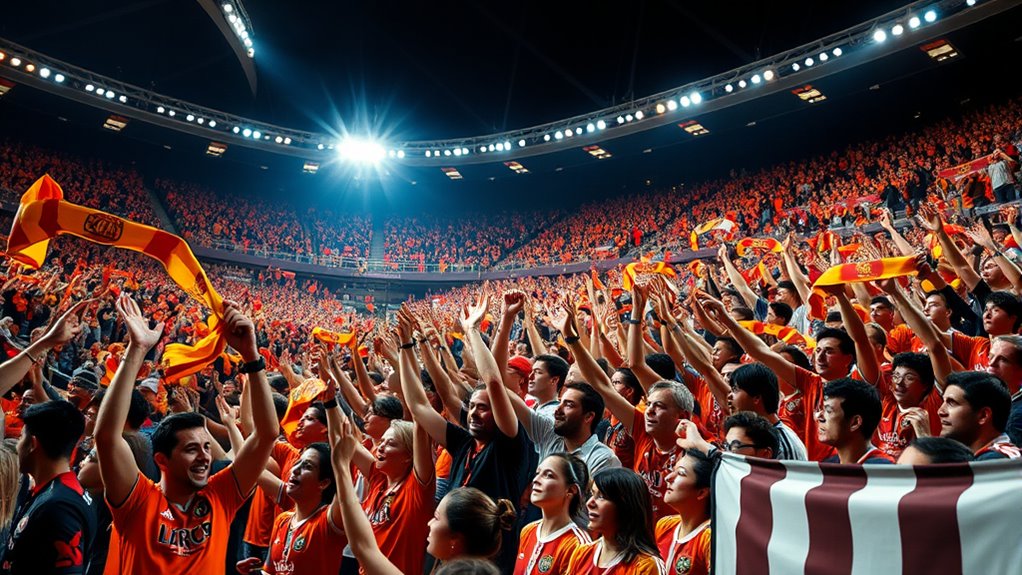
When supporters sing together, they forge a powerful sense of group identity that unites individuals beyond personal differences. Chants serve as a form of symbolism, representing shared values, loyalty, and belonging. This collective singing creates a bond that fosters group cohesion, making supporters feel part of something bigger than themselves. The rhythm and lyrics reinforce a common purpose, transforming individual voices into a unified chorus. As you participate, you contribute to the collective energy that energizes the crowd and strengthens community ties. These chants act as a social glue, reinforcing team loyalty and creating lasting memories. Ultimately, song becomes a tool for expressing identity, building solidarity, and celebrating the collective spirit that unites fans in their passion. Additionally, the act of singing together can serve as a cultural expression, highlighting the importance of shared traditions in fostering community bonds.
Language, Symbols, and Meaning in Fan Chants
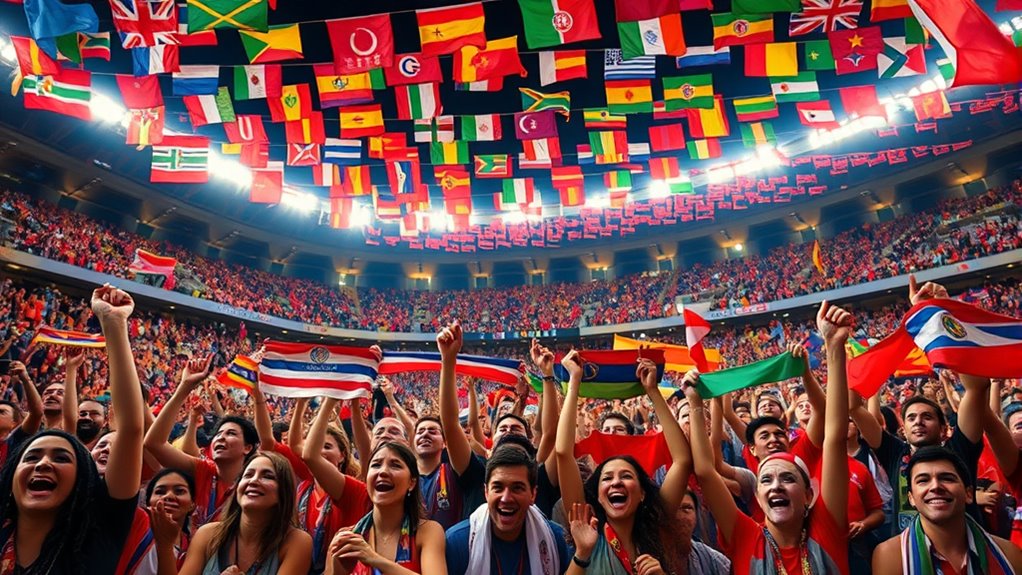
Fan chants are more than just melodies; they’re crafted with specific language and symbols that carry deep meaning for supporters. You’ll notice how linguistic creativity shapes chants, using clever wordplay and local dialects to express passion. Symbols, like team colors or mascots, serve as visual cues that reinforce group identity through symbolic communication. These elements help supporters feel connected and united in purpose. Additionally, the layered meaning often includes emotional support, strengthening bonds among fans and fostering a sense of community beyond the game.
- The language often incorporates inside jokes or regional slang that deepen community bonds
- Symbols like banners and colors become rallying points, conveying collective identity
- Meaning is layered, blending team pride with cultural expressions that resonate beyond the game
Understanding these aspects reveals how language and symbols transform simple chants into powerful tools of expression and unity.
The Role of Fan Chants in Rituals and Ceremonies
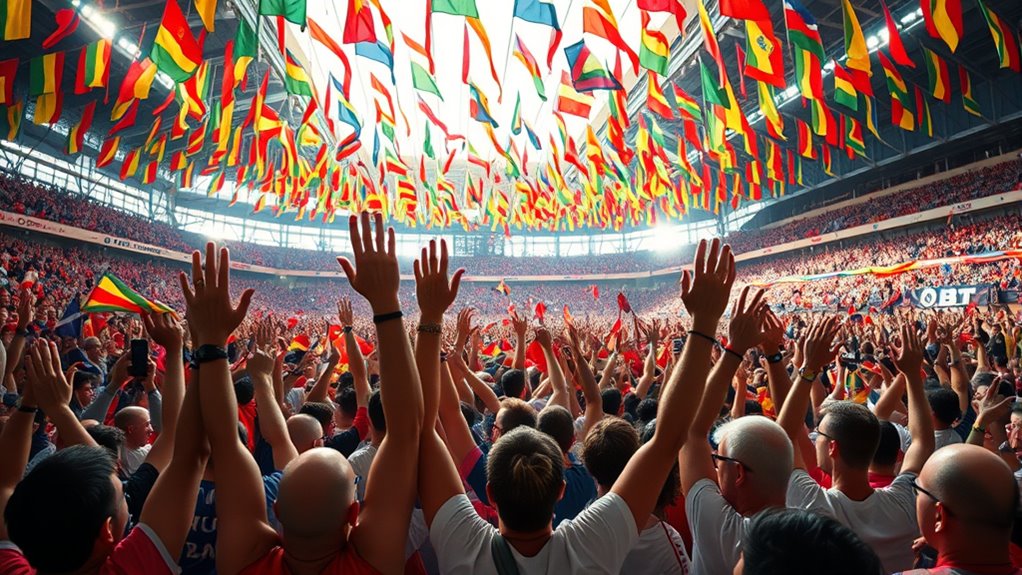
Fan chants play a essential role in rituals and ceremonies, serving as powerful expressions of collective identity and solidarity. They embody chants symbolism that unites participants, transforming individual voices into a cohesive ritual performance. These chants often mark significant moments, reinforcing group bonds and cultural values. During rituals, chants become more than sound; they create an atmosphere of shared purpose. To deepen your understanding, consider this table:
| Aspect | Explanation |
|---|---|
| Chants symbolism | Represent cultural beliefs and group identity |
| Ritual performance | Chants intensify emotional engagement |
| Collective identity | Strengthened through synchronized voices |
Through these elements, fan chants elevate rituals, turning spectatorship into a profound communal experience. Additionally, the powerful emotional impact of chants enhances the overall significance of the ceremony.
Modern Influences and the Evolution of Fan Vocal Expressions
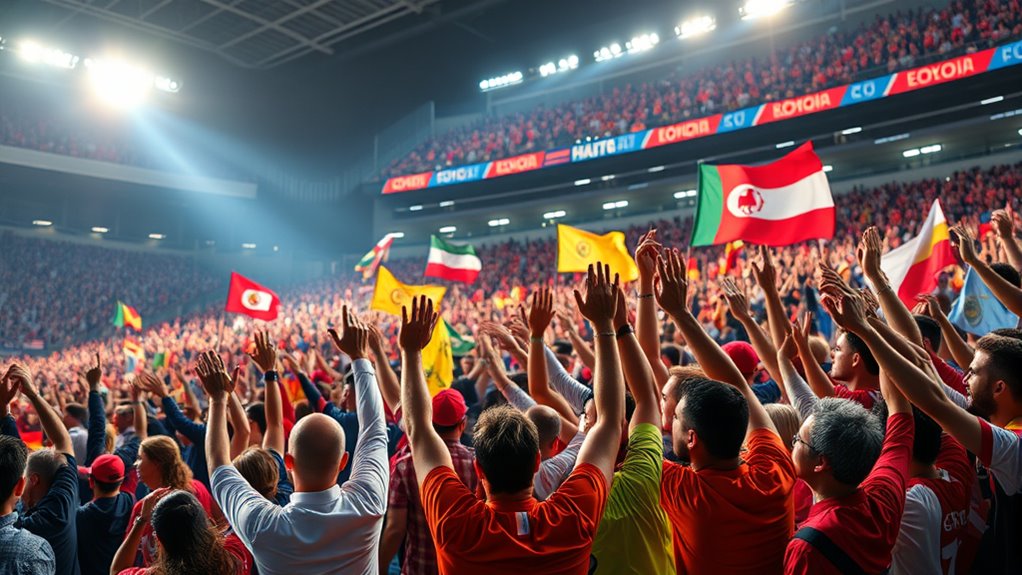
Modern technology has dramatically transformed how fans express their support through vocal chants, blending traditional methods with new digital influences. Digital amplification allows chants to reach larger audiences instantly, creating a shared experience across borders. Globalization effects mean chants now transcend local arenas, uniting fans worldwide and fostering a global fan culture. You can now participate in or witness chants through social media, live streams, and apps, amplifying their impact. This shift encourages innovation, with fans adopting or adapting chants to fit digital platforms. Furthermore, the use of Gold IRA concepts in digital fundraising campaigns demonstrates how financial tools are increasingly integrated into fan culture, promoting engagement and investment.
- Sharing chants globally via social media
- Using apps to coordinate synchronized singing
- Incorporating digital effects for added excitement
These developments deepen emotional bonds and expand the reach of fan expressions, making chants a more dynamic and interconnected phenomenon.
Frequently Asked Questions
How Do Fan Chants Influence Fan Behavior off the Stadium?
Fan chants can profoundly influence your behavior off the stadium by strengthening group cohesion and reinforcing your shared identity. When you join in chants, you feel more connected to fellow fans, creating a sense of belonging. This collective experience extends beyond the game, prompting you to support your team more passionately in everyday life. It builds pride and loyalty, making you feel part of a larger community that shares your enthusiasm and identity.
What Psychological Effects Do Fan Chants Have on Players?
Fan chants boost player motivation by creating a supportive atmosphere that fuels their confidence. When you hear enthusiastic chants, it can reduce your stress, helping you stay focused and perform better under pressure. The collective energy from fans offers psychological comfort, making you feel connected and valued. This positive influence can enhance your resilience during tough moments, ultimately improving your overall mental state and athletic performance.
Are There Gender Differences in Fan Chanting Practices Worldwide?
Imagine a stadium where gender roles shape fan chants differently across cultures. You’ll notice that in some societies, men lead loud chants, reinforcing traditional norms, while women’s participation varies based on cultural expectations. Data shows that cultural norms heavily influence gender roles in fan chanting worldwide, with some regions encouraging equal participation and others limiting it. These differences highlight how gender influences fan behavior across diverse sporting communities.
How Do Technology and Social Media Impact Fan Chant Traditions?
You see how technology and social media transform fan chant traditions through digital amplification, making chants more widespread and immediate. You can customize your chants easily, sharing ideas and variations online to fit different contexts. This connectivity encourages creativity, allowing fans to adapt chants for new events or teams quickly. Overall, social media enhances the sense of community, preserving and evolving chant practices while making them more interactive and personalized.
Can Fan Chants Promote Intercultural Understanding or Cause Conflicts?
Fan chants can promote intercultural understanding by showcasing unique traditions and fostering cultural exchange among diverse groups. However, they can also cause conflicts if chants are misinterpreted or seen as disrespectful, threatening group identities. You might find that chants reinforce your own cultural identity, but it’s essential to remain open-minded. Respecting different traditions encourages positive interactions and helps build bridges across cultures during sporting events or gatherings.
Conclusion
You might be surprised to learn that over 80% of sports fans worldwide participate in chanting during games, highlighting its power to unite communities. Fan chants aren’t just noise—they’re rich cultural expressions that foster identity, boost morale, and preserve tradition. As these vocal rituals evolve with modern influences, they continue to deepen your connection to the sport, the team, and fellow fans. Embrace these chants; they’re more than sound—they’re a essential part of shared human experience.
